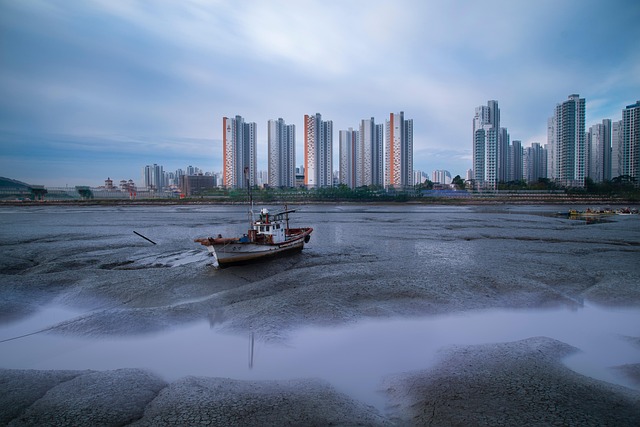After flooding in San Antonio, swift action is crucial for repairing water-damaged drywall. Residents should follow seven simple steps: assess damage, remove affected drywall, dry out the area, clean and prepare, install new drywall if needed, seal and patch, then sand and prime. Professional interior restoration services employ advanced techniques to ensure thorough drying, sanitation, and mold prevention, restoring homes swiftly and safely.
In the aftermath of a flood, the road to recovery begins with understanding the extent of damage and seeking professional help. Flood waters can leave behind not only visible water stains but also hidden moisture that poses significant risks to your home’s structural integrity, leading to issues like mold growth and weakened drywall. For San Antonio residents, prompt action is key. This guide offers valuable insights into water-damaged drywall repair tips, while highlighting the crucial role of professional interior restoration services in restoring your home to its pre-flood condition.
- Understanding Flood Damage and Its Impact on Homes
- The Role of Professional Interior Restoration Services
- Step-by-Step Guide to Water-Damaged Drywall Repair for San Antonio Residents
Understanding Flood Damage and Its Impact on Homes

Flood damage can have a profound impact on homes, especially in areas prone to severe weather events like San Antonio. When water intrudes into a residence, it doesn’t just cause visible destruction; it also leads to hidden issues that require professional attention. Water-damaged drywall is a common concern after a flood, as water can penetrate walls and ceilings, causing structural damage and fostering mold growth if not addressed promptly. For San Antonio residents facing this challenge, understanding the severity of the situation is crucial.
The aftermath of flooding exposes homes to various risks. Moisture can weaken drywall, leading to cracks, bulges, or even complete collapse. Moreover, water often carries debris, bacteria, and other contaminants, making it essential to implement proper restoration techniques. Drywall repair tips specific to water-damaged areas are vital for San Antonio residents. Prompt action, including removing saturated materials, using specialized drying methods, and adhering to strict hygiene standards, can prevent further deterioration and ensure a healthier living environment.
The Role of Professional Interior Restoration Services

When San Antonio residents face flood damage, professional interior restoration services are essential for a swift and effective recovery. Water-damaged drywall is a common issue after floods, and it requires specialized expertise to repair properly. Delve into the world of restoration services, where trained professionals offer crucial water-damaged drywall repair tips tailored to local needs in San Antonio.
These experts employ advanced techniques and tools to address not just visible damage but also hidden moisture issues, ensuring that the property is thoroughly dried and sanitized. Their goal is to restore not only the structural integrity of homes or businesses but also to create a safe and healthy environment for residents. By enlisting their services, San Antonio homeowners can expect a meticulous process that involves drying, decontaminating, and repairing water-damaged drywall, leaving behind a restored space free from mold and other hazardous effects often associated with flood damage.
Step-by-Step Guide to Water-Damaged Drywall Repair for San Antonio Residents

If your San Antonio home has experienced flooding, one of the most crucial steps in the restoration process is repairing water-damaged drywall. Here’s a step-by-step guide to help San Antonio residents navigate this task efficiently:
1. Assess the Damage: Begin by evaluating the extent of the water intrusion and subsequent damage. Check for mold growth, structural instability, or any signs of rot, as these could indicate more extensive issues that require professional attention.
2. Remove Damaged Drywall: Using a utility knife, carefully cut away the damaged drywall, creating a safe space to access and repair underlying structures. Take caution to avoid damaging nearby materials during this process.
3. Dry Out the Area: Ensure the area is thoroughly dried using fans, dehumidifiers, or other drying equipment. Properly drying the space prevents mold growth and promotes optimal conditions for effective repairs.
4. Clean and Prepare: Once dry, carefully clean the affected area to remove any remaining moisture, debris, or mold spores. Use a vacuum or damp cloth to ensure a spotless surface ready for repair.
5. Install New Drywall (if necessary): If the drywall is beyond repair, measure, cut, and install new pieces, ensuring they fit seamlessly into the space.
6. Seal and Patch: Apply a suitable sealer around the edges of the repaired area to prevent water intrusion in the future. Use a putty knife to fill any gaps or holes with drywall compound, smoothing the surface for a flawless finish.
7. Sand and Prime (if needed): Lightly sand the repaired area to ensure the compound is smooth and even. Prime the surface with a suitable primer to enhance adhesion before applying final coats of paint.
When dealing with flood damage, seeking professional interior restoration services is key to effective recovery. As highlighted in this article, understanding the extent of water-damaged drywall repair is crucial for San Antonio residents. By following specific steps and considering expert assistance, homeowners can ensure their properties are restored safely and efficiently, minimising further issues and providing a fresh start. Remember, prompt action and the right expertise make all the difference in managing flood damage effectively.
